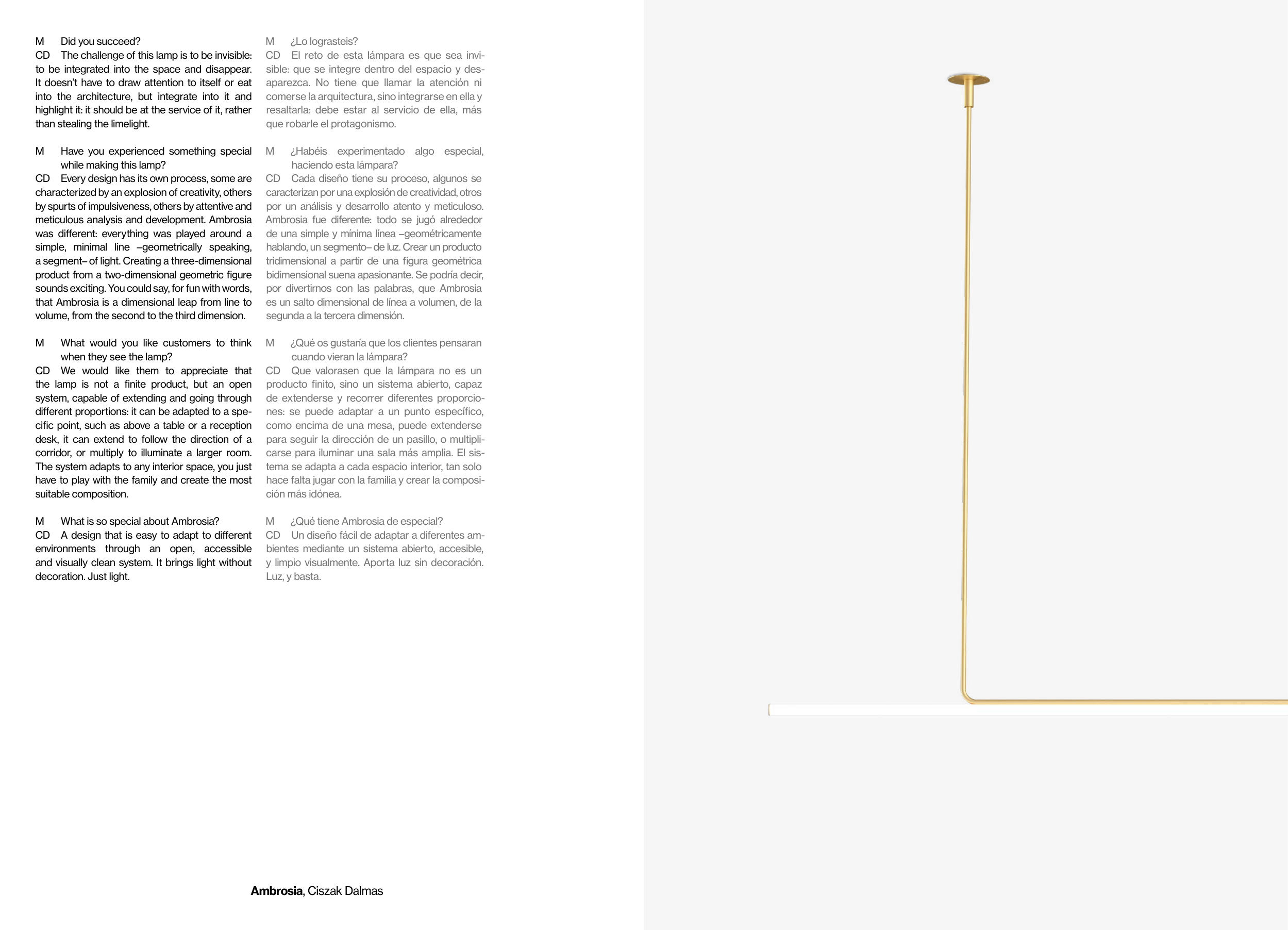Did you succeed?
The challenge of this lamp is to be invisible:
to be integrated into the space and disappear.
It doesn’t have to draw attention to itself or eat
into the architecture, but integrate into it and
highlight it: it should be at the service of it, rather
than stealing the limelight.
Have you experienced something special
while making this lamp?
Every design has its own process, some are
characterized by an explosion of creativity, others
by spurts of impulsiveness, others by attentive and
meticulous analysis and development. Ambrosia
was different: everything was played around a
simple, minimal line –geometrically speaking,
a segment– of light. Creating a three-dimensional
product from a two-dimensional geometric figure
sounds exciting. You could say, for fun with words,
that Ambrosia is a dimensional leap from line to
volume, from the second to the third dimension.
What would you like customers to think
when they see the lamp?
We would like them to appreciate that
the lamp is not a finite product, but an open
system, capable of extending and going through
different proportions: it can be adapted to a spe-
cific point, such as above a table or a reception
desk, it can extend to follow the direction of a
corridor, or multiply to illuminate a larger room.
The system adapts to any interior space, you just
have to play with the family and create the most
suitable composition.
What is so special about Ambrosia?
A design that is easy to adapt to different
environments through an open, accessible
and visually clean system. It brings light without
decoration. Just light.
¿Lo lograsteis?
El reto de esta lámpara es que sea invi-
sible: que se integre dentro del espacio y des-
aparezca. No tiene que llamar la atención ni
comerse la arquitectura, sino integrarse en ella y
resaltarla: debe estar al servicio de ella, más
que robarle el protagonismo.
¿Habéis experimentado algo especial,
haciendo esta lámpara?
Cada diseño tiene su proceso, algunos se
caracterizan por una explosión de creatividad, otros
por un análisis y desarrollo atento y meticuloso.
Ambrosia fue diferente: todo se jugó alrededor
de una simple y mínima línea –geométricamente
hablando, un segmento– de luz. Crear un producto
tridimensional a partir de una figura geométrica
bidimensional suena apasionante. Se podría decir,
por divertirnos con las palabras, que Ambrosia
es un salto dimensional de línea a volumen, de la
segunda a la tercera dimensión.
¿Qué os gustaría que los clientes pensaran
cuando vieran la lámpara?
Que valorasen que la lámpara no es un
producto finito, sino un sistema abierto, capaz
de extenderse y recorrer diferentes proporcio-
nes: se puede adaptar a un punto específico,
como encima de una mesa, puede extenderse
para seguir la dirección de un pasillo, o multipli-
carse para iluminar una sala más amplia. El sis-
tema se adapta a cada espacio interior, tan solo
hace falta jugar con la familia y crear la composi-
ción más idónea.
¿Qué tiene Ambrosia de especial?
Un diseño fácil de adaptar a diferentes am-
bientes mediante un sistema abierto, accesible,
y limpio visualmente. Aporta luz sin decoración.
Luz, y basta.
M
CD
M
CD
M
CD
M
CD
M
CD
M
CD
M
CD
M
CD
Ambrosia, Ciszak Dalmas


